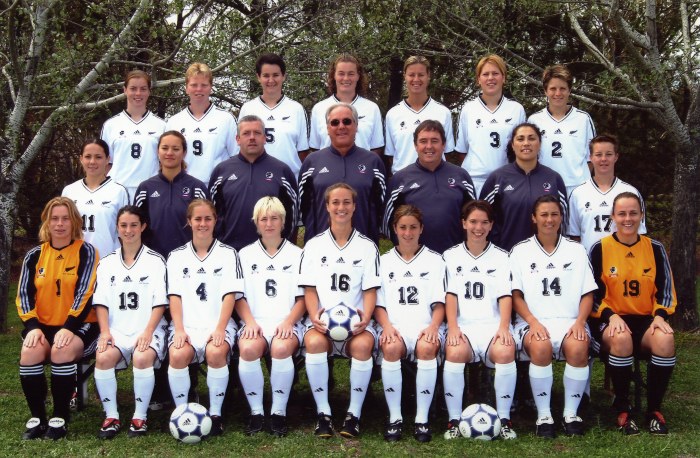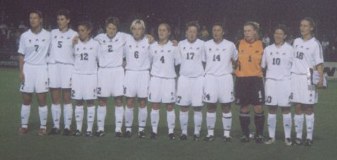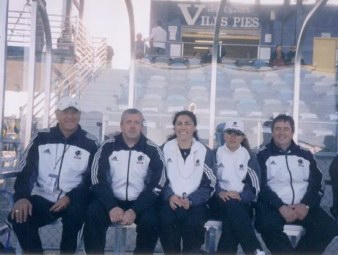The Ultimate New Zealand Soccer Website | home
1996 Tri-Series and PNG | 1997 Tri-Series Review | 1998 Oceania WWC Qualifying Review | 2000 Pacific Cup Review | 2001 ICL Tournament | 2003 Oceania WWC Campaign | 2004 Australia Cup | 2004-5 - USA and Japan | The Elite Squad
2003 Oceania WWC Campaign

SWANZ Back In Action After Lengthy Absence
by Jeremy Ruane
penned mid-March, 2003
Tour Schedule
Date
|
Venue
|
Score
|
Opponents
|
Scorers
|
19/3/03
|
Waco
|
3-2
|
Baylor University
|
N. Smith (2), S. Ferrara (pen)
|
21/3/03
|
Austin
|
2-6
|
Univ. of Texas
|
M. Keinzley, L. O'Meara
|
24/3/03
|
College Station
|
3-1
|
Texas A&M
|
M. Jackman (2), N. Smith
|
27/3/03
|
Amarillo
|
3-2
|
West Texas A&M
|
M. Jackman, L. O'Meara, M. Keinzley
|
29/3/03
|
Amarillo
|
1-1
|
West Texas A&M
|
N. Smith
|
7/4/03
|
Canberra
|
15-0
|
Samoa
|
N. Smith (5), M. Jackman (4), S. Ferrara (3), M. Keinzley (2), H. Moorwood
|
9/4/03
|
Canberra
|
9-0
|
Cook Islands
|
M. Jackman (3), S. Ferrara (2, incl. pen.), W. Henderson, T. McCahill,
J. Simpson, N. Smith
|
11/4/03
|
Canberra
|
5-0
|
Papua New Guinea
|
M. Jackman (3), P. Duncan, N. Smith
|
13/4/03
|
Canberra
|
0-2
|
Australia
|
April 2003 canít come soon enough for New Zealandís national womenís soccer team, the SWANZ.
Their first match of the Oceania qualifying series for the fourth FIFA Womenís World Cup will mark just their sixth ĎAí international since being beaten 3-1 by arch-rivals Australia in the 1998 final of the qualifiers for the 1999 Womenís World Cup Finals, the tournament which has set the benchmark for international womenís soccer in the early years of the 21st century.
Since then, apart from taking part in the inaugural Pacific Cup tournament across the Tasman in June 2000, the SWANZ have been conspicuous by their absence on the international stage - a far cry from the days some fifteen years ago, when the Kiwi representatives were among the worldís top four womenís soccer-playing nations, as emphasised by their performances at the 1987 World Womenís Invitational Football Tournament in Taiwan.
During that event, New Zealand recorded arguably their greatest ever victory on the international stage, when they scored a 1-0 win over a USA side boasting the then-fresh-faced trio of Joy Fawcett, Mia Hamm and Kristine Lilly, and current coach April Heinrichs, in their starting line-up, not to mention second half substitutes (and fellow womenís soccer legends) Michelle Akers and Carin Jennings.
It speaks volumes for the respective paths taken by the two countries in the ensuing years that were that scoreline to be repeated today, it would easily rank as the biggest upset in the history of the womenís game - no question.
That is one of the prices New Zealand has to pay for the countryís geographic location, tucked away in a small corner of the South Pacific where few of the worldís footballing powers - club or representative - dare travel, so prohibitive are the costs when compared with the prospect of playing a couple of games at most.
For the same reason, it requires a significant investment by the gameís governing body, New Zealand Soccer, to, nowadays, enable the SWANZ to broaden their horizons beyond the confines of the Oceania region.
For a few years now, that investment hasnít been forthcoming - the last time New Zealand travelled the world was on the 1998 Championsí Tour, when they played two matches against European champions Germany before crossing the Atlantic to face the Olympic champions, the USA, prior to the Oceania qualifying tournament.
During the ensuing years of relative inactivity on the international stage, the hopes of donning the white jersey of their country once again came to an end for a few players.
Included amongst these are a couple of our finest-ever female footballers, namely Michele Cox and Amanda Crawford, both of whom have fallen victim to knee injuries brought about by the combination of regular wear and tear, and the extra efforts they have put in over the years to, firstly, earn, then maintain their ranking among the true greats of New Zealand womenís soccer.
That inactivity and lack of investment is about to come to an end, however, with the SWANZ set to embark on a five-match series of games against American University sides in late March, before heading direct to Canberra for the Oceania Womenís World Cup qualifying tournament in April.
Understandably, the players are delighted with the chance to represent their country once again, as midfield dynamo Simone Ferrara explains. "Iím very excited about putting my jersey back on. There is nothing that can really describe the feeling you get when you put that jersey on and know you are representing your country".
For goalkeeper Rachel Howard, her selection is a reward for a lot of hard work, as she hasnít played for her country since that Oceania qualifying final in 1998. "It is always an honour to be selected for your country, whether it be for the first time or recalled. This time it has a different meaning than the first time I played for New Zealand.
"The first time, I was elevated as a young twenty-year-old from a development Ďkeeper to number one through a couple of unforeseen events", recalls the Adidas NZ Marketing Assistant. "This time, I felt I have really earned my position in the team through some hard work. However, the work hasnít finished, as there are still the starting positions up for grabs".
Eighteen-year-old playmaker, Hayley Moorwood, one of seven new caps chosen by coach Sandy Davie in the eighteen-strong squad, will realise a life-long ambition when the SWANZ take to the pitch in both Texas and Canberra.
"Ever since I started playing soccer, itís been my dream to play for the New Zealand womenís team, and now that dream is coming true. Iím absolutely rapt with my selection, and I canít wait to get on the field and kick the ball for my country".
While they havenít kicked a ball in anger for, quite literally, months, New Zealand womenís soccerís elite havenít been adopting the role of couch potatoes, watching their televisions for the briefest glimpse of the international womenís soccer scene they so much want to be a part of on a regular basis. Far from it.
Only last year, US-based Ferrara and Auckland star Maia Jackman were among the players invited to play in the inaugural Chinese Womenís Super League
|
SWANZ World Cup Squad
Eleven brave strong women and true sing
"God Defend New Zealand" on April 13, 2003, but what they're thinking is "God help Australia"!!
 Meanwhile, here's the squad's support crew in Canberra in 2003 ...
 conveniently located below a certain vendor's sign. Which leads to the burning question of the day, "Who ate all the pies?!?!"
The prime suspects are (l to r): Sandy Davie (coach), George Smith (GK coach), Christine Darken (manager), Jocelyn Hayward (physio), Fred Simpson (assistant coach)
competition, with Jackman in particular earning rave reviews for her performances in the colours of Dalian Shide.
Across the Pacific, new cap Priscilla Duncan is in the first year of a scholarship at the South-West Baptist University in Missouri, where she will be joined by Moorwood and another fine young prospect, Amber Hearn, later this year.
Meanwhile, Duke University graduate Rebecca Smith is now playing alongside Ferrara at Southern Californian team Ajax, in the WPSL competition, one step down from womenís soccerís first professional league, the WUSA.
For the locally-based players, however, the advent of a provincially-based National Womenís Soccer League in 2002 has been the major highlight, but itís fair to say their preparation for international action has not been anywhere near as memorable, as no-nonsense defender Jane Simpson confirms.
"To win the World Cup qualifiers in Australia will be a challenging task for all involved. Our road to the World Cup has been non-existent over the last two years, while our main rivals, the Matildas, have played twenty-four internationals and held a series of monthly training camps since we last faced them in the Pacific Cup.
"One would think the Australians have the upper hand, and given their natural cockiness and confidence, they will expect to win based on our previous results". (Australia have won the last eight encounters between the trans-tasman rivals).
"So will we win?", asks Simpson, rhetorically. "Do we have the guts and determination to outsmart the opposition, be that Australia or any other team that stands in our way?
"Our preparation has been poor, but our hearts are huge. We will be fit enough, the players will play with every ounce of determination, and on the day it will come down to tactics. We know what the Matildas are capable of, and we need to play to our strengths - strengths that will be groomed through the five games we play in Texas. So the win is possible".
Howard expands on this theme. "The Texas tour is a good base from which we can develop as a team, and for us to put all the training we have done into some game situations.
"This build-up is similar to the last campaign in 1998, although I feel it will be more beneficial, with the team travelling straight from the US to the qualifiers, providing continuity we didnít experience in the previous qualifying schedule.
"Also, the level of competition from the colleges will be of a standard where we can compete, as opposed to defending the whole time, as was the
|
case on the Champions Tour. This will give us greater confidence and a platform to develop our game, both defensively and attack-wise.
"The vibes from the last camp were very positive from both the team and management. We know that we havenít had the best preparation, but at the end of the day, itís all about giving it our best on what we have had. We have a team with a great mix of experience and talent, and add to that the heart we all have, and I think, come April, the SWANZ may just surprise a few people".
The last two years have seen the SWANZ taking part in a number of training camps, as well as a quadrangular tournament involving representative teams from Queensland and South Australia. For a number of the younger players, their route to the national team came via involvement in the inaugural Oceania Under-19 Womenís World Cup qualifying tournament.
But the playersí desire to be among those appearing in China between September 24 and October 11 this year has been emphasised by their willingness to ensure they are as prepared as they possibly can be, both physically and technically, with plenty of personal training.
Moorwood, already one of the brightest stars on the Auckland soccer scene despite her tender years, is living proof of this desire to be ready for anything the opposition can throw at her. "Iíve been training six days a week for some time now, as well as carrying out my own running and sprinting programme. Pre-season training at Lynn-Avon United has also commenced Ö". Phew!
Simpson, who plays in the southern stronghold of Christchurch, is training alongside her Mainland team-mates in the lead-up to heading offshore. "The five of us have been working on base fitness over the last few weeks since the camp in Auckland.
"For the next six weeks, weíll be training with men and boys, gaining confidence on the ball by playing as much one- and two-touch football as possible - the opportunity to train with quality players in this manner will help our mental, as well as our physical preparations".
Across the seas in California, Ferrara has been working out with a colleague who is training to be ready for the soon-to-start WUSA season. "I have a few tournaments coming up with Ajax, so Iím training with them. Iím also training three times a week with the University College of Irvine team, so Iíll be raring to go when the team arrives here".
Howard, meanwhile, has been training with the goalkeepers of the Central United National League squad, including All White goalkeeping candidate Ross Nicholson. "This is great for me, as men are obviously stronger and faster, so Iím pushing myself to reach their level. It has also enabled me to work on my technique with the aid of a goalkeeping coach.
"Goalkeeping is as much mental preparation as it is physical, so I have had a few tips from our coach (and former All White goalkeeper) Sandy Davie, and have been developing plans to enable me to be as mentally prepared as physically".
Talking of plans, what lies in store for the SWANZ beyond April 13? All being well, the Womenís World Cup Finals, of course, while the Olympic Games qualifying tournament is scheduled to take place in the Cook Islands in March 2004, followed in August that year by the Athens Games.
Before then, however, the advent of FIFA womenís rankings in May will serve to emphasise the need for New Zealandís national womenís team to be playing on a far more regular basis.
Simpson, who made her SWANZ debut against Australia in 1997, eight years after illness initially denied her the opportunity, is well placed to comment on this, given her position on the board of Mainland Soccer.
"The feeling of responsibility to the soccer community every time I pull on the white jersey is immense. The rarity of international games for the SWANZ team since the last Womenís World Cup qualifiers has made me very aware of the need to get results, as results have consequences (as we saw with the All Whites beating Australia last year).
"Over the last two years I have been concerned at the second or third row position the SWANZ team has been handed out by NZ Soccer. I believe newly-appointed Director of Football, Paul Smalley, will turn that around.
"He has made it quite clear that all international representative sides are important and will all sit in the front row. Paul has not been long in New Zealand, but already his vision for the future and his leadership should be commended. I look forward to the plans he is laying down to improve the game in New Zealand".
Among the changes the former Assistant Coach of the England womenís team is introducing to New Zealand soccer is a Director of Womenís Technical Development, a full-time position which is decidedly revolutionary for the womenís game in this country.
This, and the advent of a regular diet of international action, will help propel the SWANZ back towards those heady heights of 1987, as will a successful return to the international scene this April, culminating in clinching the Oceania crown for the first time since qualifying for the inaugural Womenís World Cup Finals, which also took place in China, in 1991.
|